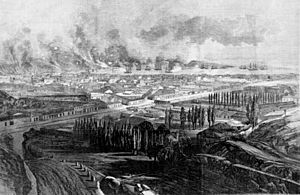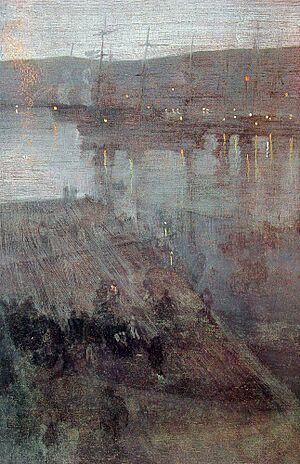Bombardment of Valparaíso facts for kids
Quick facts for kids Bombardment of Valparaíso |
|||||||
|---|---|---|---|---|---|---|---|
| Part of Chincha Islands War | |||||||
 The Spanish fleet shelling the port of Valparaíso |
|||||||
|
|||||||
| Belligerents | |||||||
| Commanders and leaders | |||||||
| N/A | |||||||
| Strength | |||||||
| 1 ironclad 5 frigates 1 corvette |
N/A | ||||||
| Casualties and losses | |||||||
| none | 2 killed 10 wounded 33 ships sunk |
||||||
The Bombardment of Valparaíso happened on March 31, 1866. It was a major event during the Chincha Islands War. A Spanish fleet attacked, burned, and destroyed the port of Valparaíso in Chile. At the time, Valparaíso was a very important port city, but it had no defenses.
Contents
Why Valparaíso Was Attacked
After some battles, like the Battle of Papudo and the Battle of Abtao, the Spanish Rear Admiral Casto Méndez Núñez was told to attack South American ports. Chile had also stopped allowing ships that helped the Spanish fleet into its ports. Because of this, Valparaíso became the main target. It was Chile's most important port and had no military defenses.
Attempts to Stop the Attack
Many people tried to stop the attack. European diplomats, whose countries had a lot of trade in Chile, tried to help. They talked a lot between London, Paris, and Madrid. For a while, it seemed like they might find a solution.
In the last two weeks before the attack, the United States tried very hard to help. The American minister to Chile, General Hugh Judson Kilpatrick, and US Naval Commander John Rodgers were in Valparaíso. They had a US naval squadron with ships like the USS Monadnock and Powhatan. They tried to make a deal with the Spanish Admiral.
They also asked for help from the British commander, Rear Admiral Joseph Denman. He had two warships, HMS Sutlej and HMS Leander. British merchants in Valparaíso really wanted him to protect the city. But after talking with the main British diplomat, William Taylour Thomson, Admiral Denman decided to stay neutral. This meant his ships would not get involved. Thomson was more worried about Spanish people living in Chile and did not want to make Spain angry.
In the end, none of the peace talks worked. The Spanish Admiral, Méndez Núñez, had three main demands:
- The Chilean government had to salute the Spanish flag.
- Chile had to return a captured Spanish ship called the Covadonga.
- Chile had to pay a very large sum of money.
The talks completely broke down over the flag salute. General Kilpatrick even threatened to use his US ships to defend the port and attack the Spanish fleet. Admiral Méndez Núñez famously replied, "I will be forced to sink [the US ships], because even if I have one ship left I will proceed with the bombardment. Spain, the Queen and I prefer honor without ships than ships without honor." This meant he would rather lose his ships than lose Spain's honor.
Because of this, the Spanish Admiral told everyone who was not involved in the war to leave the city by March 27.
The Bombardment Begins
On March 31, at 7 AM, the Spanish fleet got into position. The ships included the Numancia, Resolución, Villa de Madrid, Blanca, Vencedora, and the captured Chilean ship Paquete del Maule. Another ship, the Berenguela, stayed behind to watch for any merchant ships trying to escape.
At 8:10 AM, the Numancia fired two warning shots. This was a final warning for anyone still in the city to find cover. The actual bombardment started at 9 AM and lasted for three hours. Valparaíso had no defenses, so no shots were fired back.
The Spanish ships attacked the city without any resistance. A lot of public and private buildings were destroyed. Many goods in the port were also ruined. The total damage was estimated to be around $10,000,000 at the time. Today, this would be like losing about $224,000,000.
This attack caused a big international stir. Spain was criticized for attacking an unarmed city. But the British government was also criticized. Many people felt they should have used their navy to protect their own citizens and their property. Most of the money lost belonged to British merchants. This led to a big debate in the British Parliament when the news arrived in May 1866.
A Famous Painting
James McNeill Whistler, a famous artist, was on board one of the American ships during this time. The night before the bombardment, he painted his famous work, "Nocturne in Blue and Gold: Valparaíso Bay." The painting shows the Chilean merchant ships waiting in the bay, knowing they were about to be destroyed.
See also
 In Spanish: Bombardeo de Valparaíso para niños
In Spanish: Bombardeo de Valparaíso para niños


